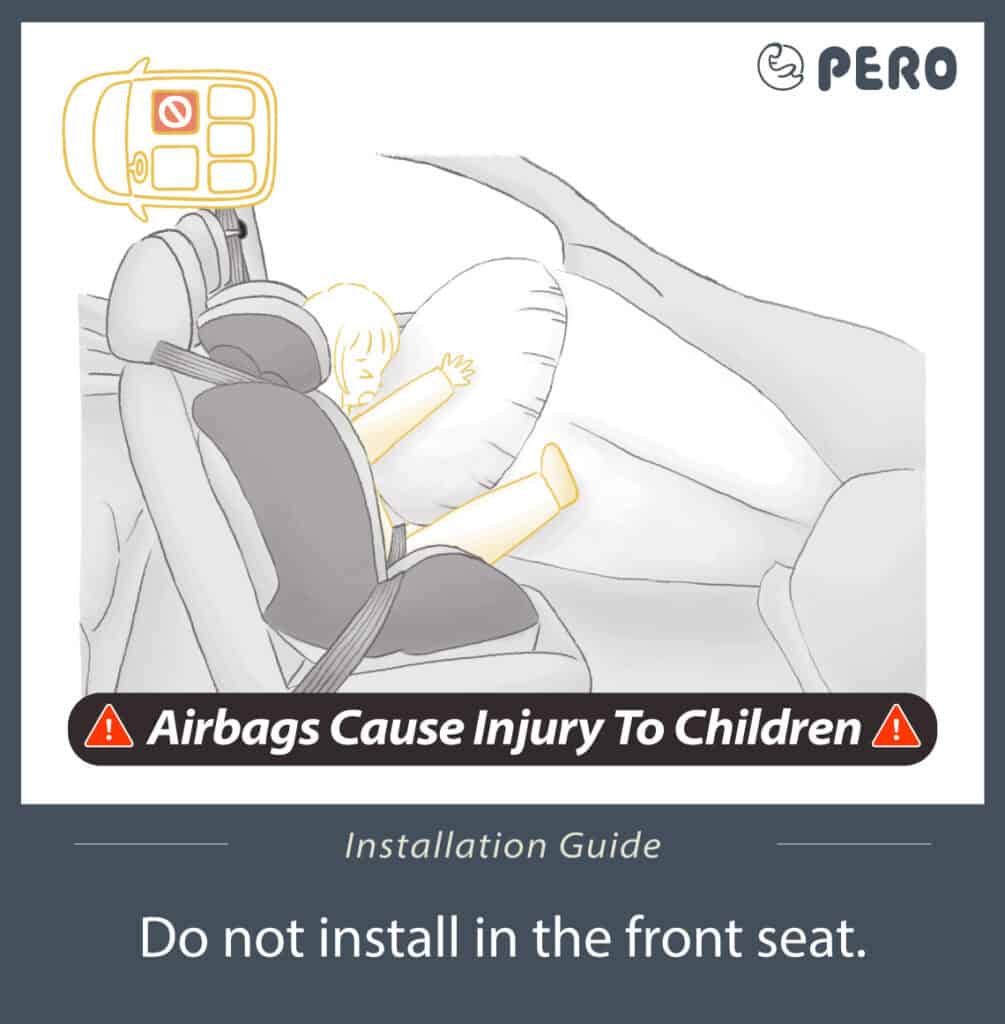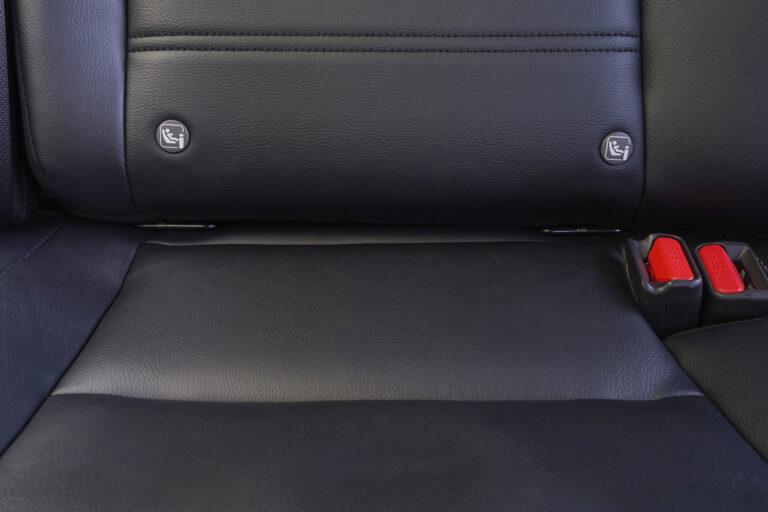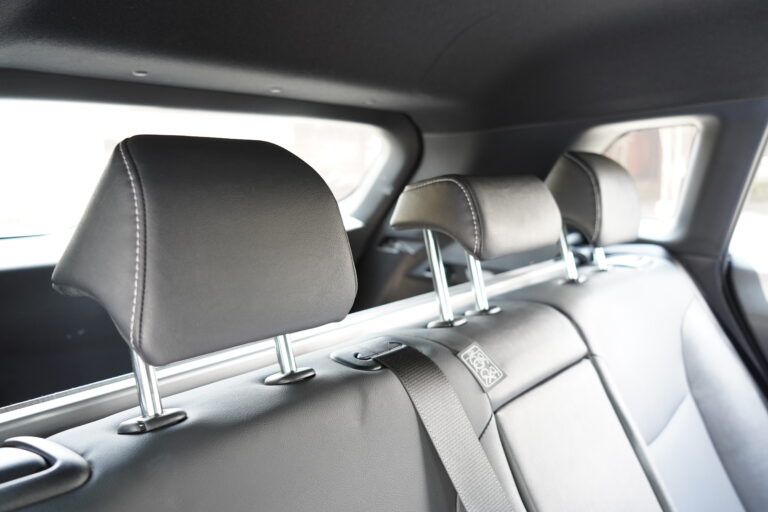Choosing where to install a car seat has always been a major concern for parents. Opinions vary widely, and even experts do not always agree. Many parents struggle with the question of how to use a car seat in a way that offers the best protection for their children during travel.
Just as there are many factors to consider when purchasing a car seat, the choice of installation position must also take multiple conditions into account. In the following section, we will explain the relevant data on installation locations, as well as the essential requirements that cars, car seats, and installation methods themselves should meet.
Car Seat Placement: Left, Right, or Middle?
This article cites statistics released by the U.S. National Highway Traffic Safety Administration (NHTSA), comparing the fatality rates of different rear seat positions over recent years. The data shows that when safety restraints (seat belts or car seats) are used, the order of lowest to highest fatality rates is as follows: rear center seat, rear passenger seat and rear driver seat.
However, it’s worth noting that the sample size for the rear center position is relatively small, with more variables involved. At present, there is no complete set of data or comprehensive study that can directly prove which position is definitively the safest for installing a car seat. So, parents—don’t rush to assume that the middle seat is always the best choice!
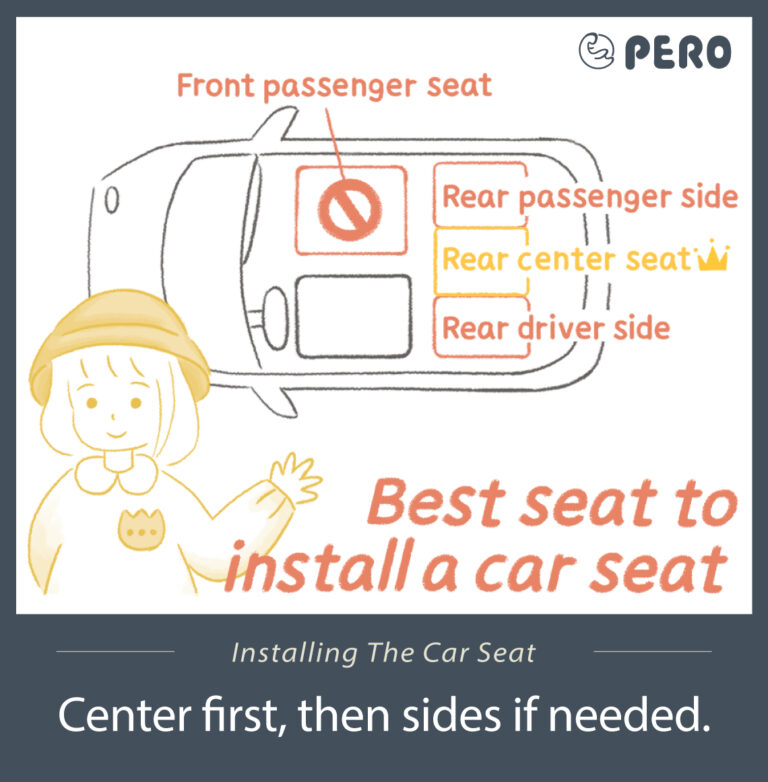
2017–2018 Passenger Vehicle Occupant Fatality Rates, by Seating Position and Seat Belt Use
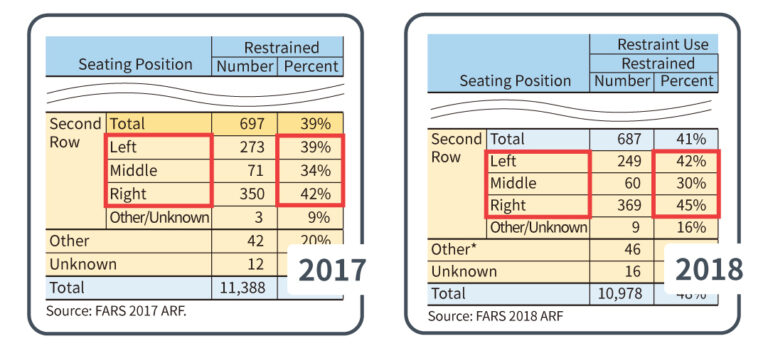
2019–2020 Passenger Vehicle Occupant Fatality Rates, by Seating Position and Seat Belt Use
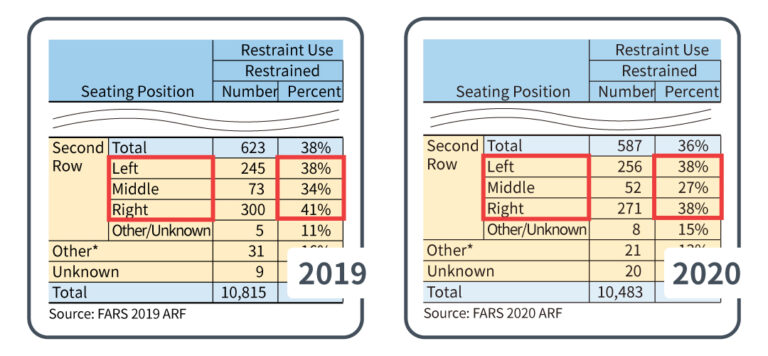
SOURCE:
NHTSA OCCUPANT PROTECTION IN PASSENGER VEHICLES 2017.2018.2019.2020 DATA,
https://crashstats.nhtsa.dot.gov/Api/Public/ViewPublication/812691
https://crashstats.nhtsa.dot.gov/Api/Public/ViewPublication/812967
https://crashstats.nhtsa.dot.gov/Api/Public/ViewPublication/813176
https://crashstats.nhtsa.dot.gov/Api/Public/ViewPublication/813326
Important Notes for Installing a Car Seat in the Center Seat
In fact, before parents get caught up in choosing the installation position, the priority is to ensure that the car seat is properly installed. Only with correct installation can the use of restraints (seat belts or ISOFIX) significantly improve protection.
We strongly recommend that parents keep the following points in mind before deciding whether installing the car seat in the rear center seat is feasible:
- Correctly install the car seat
- Check whether the specifications of the rear center seat are compatible with the car seat
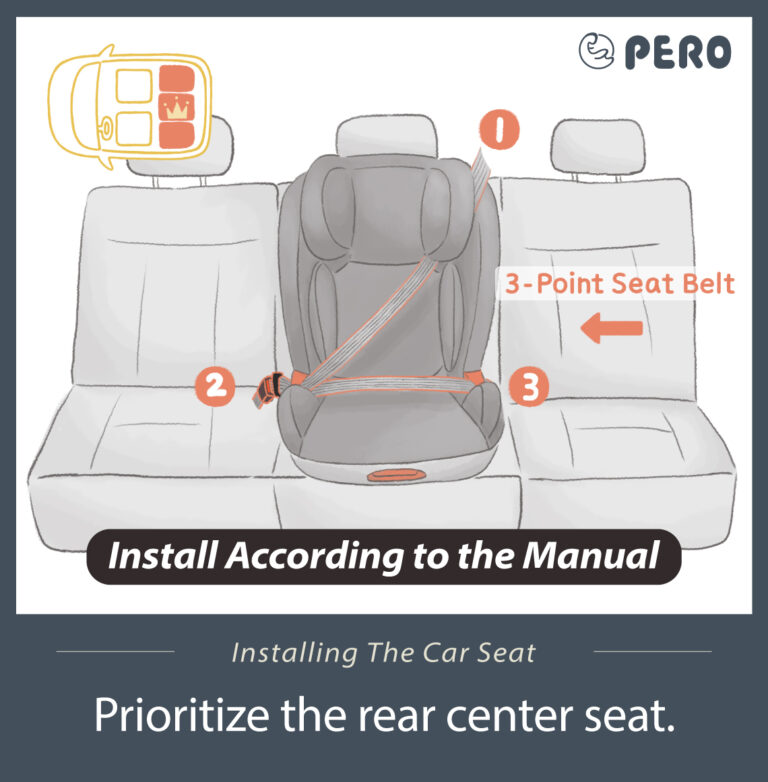
Why Correct Car Seat Installation Matters
Just as adults rely on seat belts—designed to tighten and hold the body securely in place during a crash—children under the age of 12 need proper protection as well. Since their height and weight are not fully developed, the car seat serves as their seat belt, acting as a critical line of defense for their safety on the road.
According to data released by the U.S. National Highway Traffic Safety Administration (NHTSA) in 2014, the fatality rate reached a high of 85% when passengers were ejected from the vehicle during a crash. This highlights just how crucial proper car seat use is for protecting children in a collision.
2014 Passenger Injuries and Deaths from Being Ejected from Vehicles
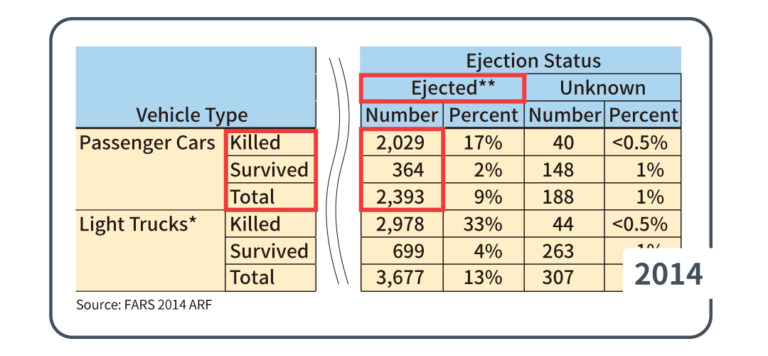
SOURCE:
NHTSA OCCUPANT PROTECTION IN PASSENGER VEHICLES 2014 DATA,https://crashstats.nhtsa.dot.gov/Api/Public/ViewPublication/812302
| Passenger Ejection | People | % |
|---|---|---|
| Injured | 364 | 15% |
| Died | 2029 | 85% |
In addition, parents should also pay attention to the compatibility between the car and the car seat. For example, a car seat that only supports ISOFIX installation must be installed using the car’s ISOFIX system, and it will not be compatible with vehicles that do not have ISOFIX.
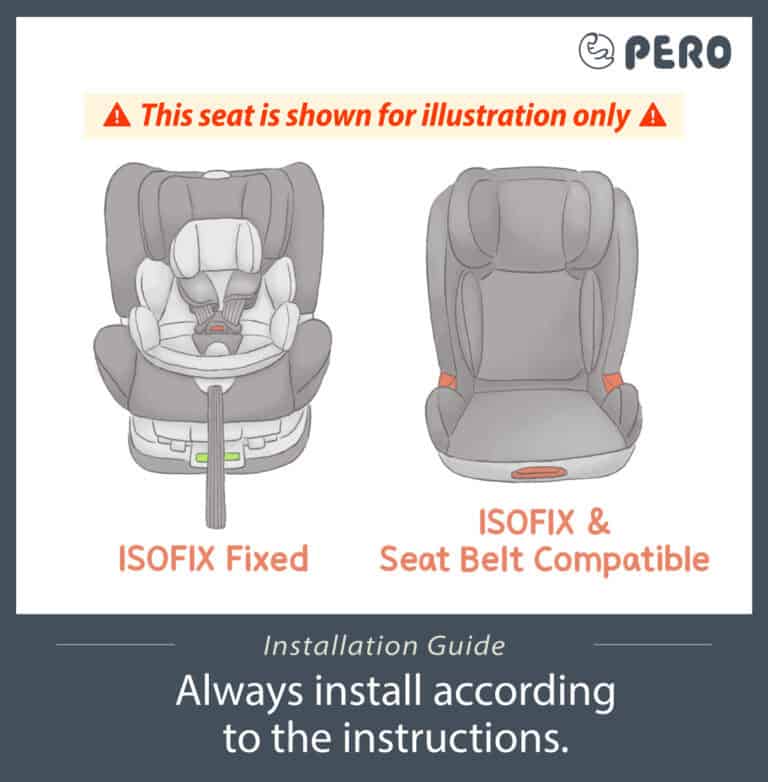
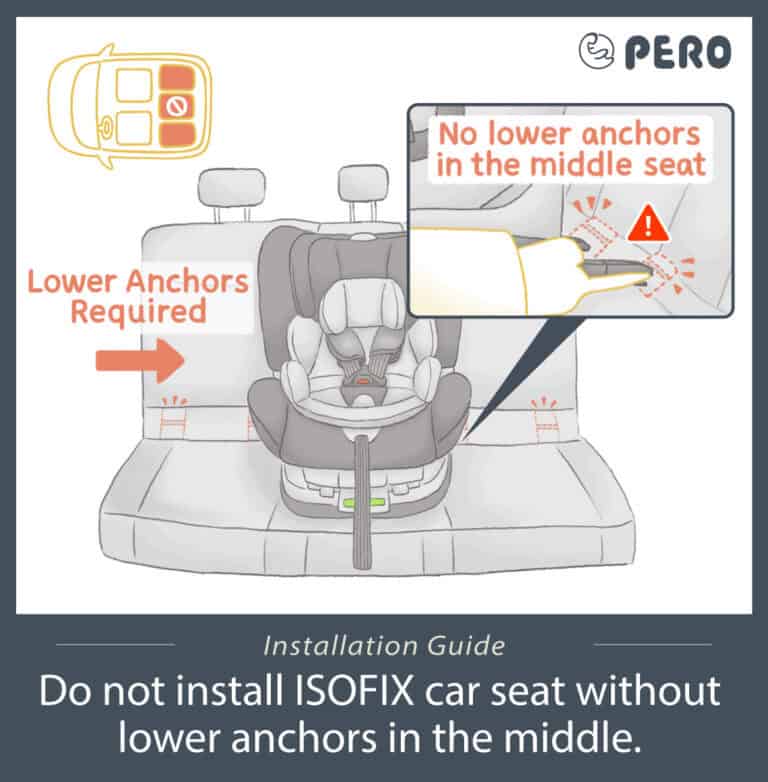
Requirements for installing a car seat in the rear center position
Installing a car seat in the rear center position requires two things to ensure compatibility with the vehicle:
- The rear center seat must have a 3-point seat belt (if ISOFIX lower anchors are available, the car seat may also be installed using ISOFIX).
- The car seat must be installed correctly and securely.
In most compact four-door sedans, commonly seen in Taiwan, the rear center seat is relatively narrow and usually equipped only with a 2-point seat belt, making car seat installation impractical. Another option is the ISOFIX system (International Standards Organization FIX), but ISOFIX lower anchors are generally provided only on the left and right rear seats, and are rarely found in the center. If ISOFIX is available in the center position, the risk of incorrect installation would be lower than when using a seat belt.
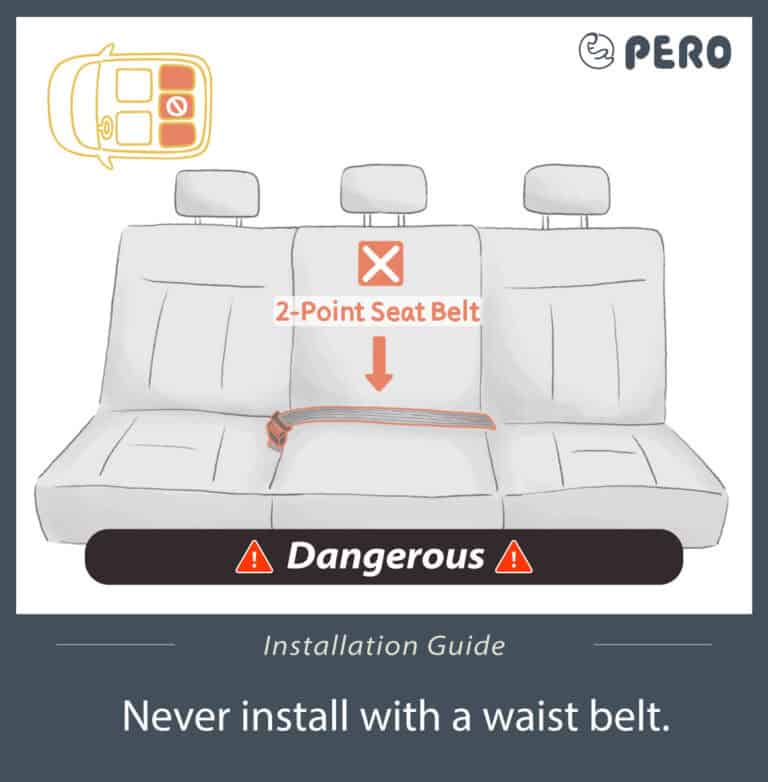
The Taiwan Journal of Criminal Policy and Criminology (Vol. 21, Studies on Traffic Accident Injuries and Forensic Applications) notes that passengers seated in the rear center position are often thrown forward due to inertia in a collision. For this reason, parents who choose to install a car seat in the center seat should take extra caution to ensure that it is installed securely and correctly.
Why is the rear center seat the safest place for a car seat?
Research published in the Taiwan Journal of Criminal Policy and Criminology (Vol. 21, Studies on Traffic Accident Injuries and Forensic Applications) show that the most common types of fatal car crashes are frontal and side impacts, occurring at nearly the same frequency. Wearing a seat belt (or using a car seat) can reduce the risk of death in a frontal crash by about 45%. In side impacts, however, injuries tend to be more severe on the side of the collision.
Source: Taiwan Journal of Criminal Policy and Criminology, Vol. 21 – Studies on Traffic Accident Injuries and Forensic Applications https://www.cprc.moj.gov.tw/media/8213/911016165682.pdf
Car Seat Placement and Side-Impact Protection
Installing a car seat in the rear center position offers greater protection in a side collision. In this location, the child is less likely to be exposed to the full force of the initial impact and is also better shielded from shattered glass or other debris caused by the crash.
To address the shortcomings of ECE R44/04, the European Union introduced the i-Size regulation (ECE R129) in 2013. Unlike its the previous requirements, i-Size requires side-impact testing in addition to frontal and rear-impact tests, ensuring a higher level of protection for children.
Mortality Rate Comparing by Child Car Seat Placement
Source:NHTSA OCCUPANT PROTECTION IN PASSENGER VEHICLES 2017.2018.2019.2020 DATA
| Year | Rear Left Seat | Rear Center Seat | Rear Right Seat |
|---|---|---|---|
| 2017 | 39% | 34% | 42% |
| 2018 | 42% | 30% | 45% |
| 2019 | 38% | 34% | 41% |
| 2020 | 38% | 27% | 38% |
From the table above, we can see that aside from the significant difference in the center seat, the mortality rates for the left and right seats are both around 40%, with only minor variations. In addition, there are uncontrollable factors in the data, such as incorrect use of safety devices (child car seats or seat belts), or defects and damage in the devices themselves.
Even though these reports provide useful references, we must once again remind parents that, ultimately, the most important factor is whether the child car seat is installed correctly.
Child Car Seat Installation in Rear Left and Right Positions
Of course, if there is more than one child in the family, or if an adult also needs to sit in the back, space limitations mean that at least one child car seat will have to be installed on either side of the rear seat.當然,若家中有一個以上的兒童,或是安排一位大人坐在後座的需求,基於空間限制,至少有一台安全座椅會安裝於汽車後座左右兩邊。
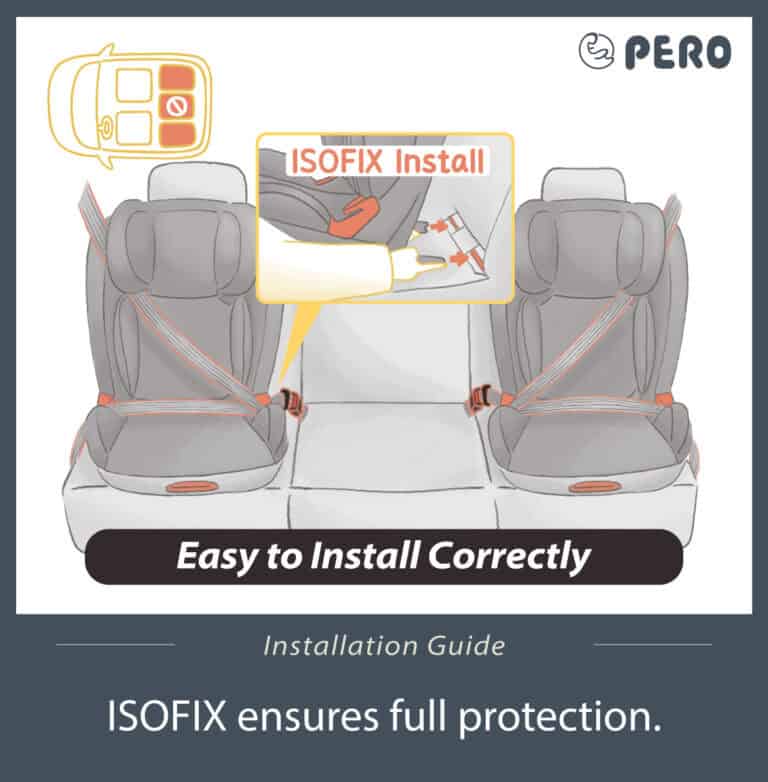
How to Install a Child Car Seat When an Adult Sits in the Back? 大人坐後座,如何安裝安全座椅?
Using Narrow Car Seats
使用窄版安全座椅
In Taiwan, most common car models have limited rear seat space. When a child car seat is installed, parents who need to sit in the back to care for their child often have to sacrifice comfort. Therefore, when choosing a car seat, it is recommended to prioritize narrow models or lightweight booster cushions, depending on the child’s height and weight.
目前在台灣較常見的車款大部分後座空間設計一般有限,在有安裝安全座椅的情況下,若家長們有坐在後座顧小孩的需求,往往必須犧牲乘坐舒適性。因此建議在安全座椅的選擇上,可以根據兒童的身高體重,優先參考窄版安全座椅或是攜帶較輕便的增高墊。
Installing Car Seats with Seat Belts 使用安全帶安裝安全座椅
Since ISOFIX anchors in cars are standardized and fixed in position, once a car seat is installed with ISOFIX, it cannot be shifted. However, if you use a car seat that supports installation with the vehicle’s three-point seat belt, the seat can be positioned slightly closer to the door, creating more space inside the vehicle. 由於汽車上的ISOFIX裝置原則上屬於公規,其位置是固定的,安全座椅安裝後即無法移動,如使用支援車用三點式安全帶安裝的安全座椅,並採用安全帶安裝的形式,則可以稍微再往車門的方向挪移,以騰出更多的空間。
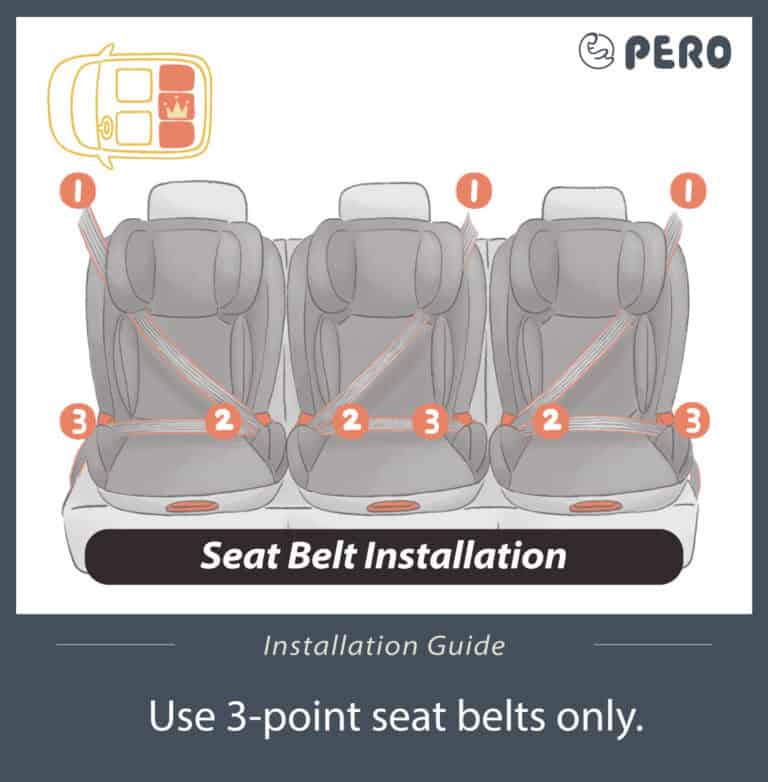
We hope every child can enjoy happy trips and create safe, comfortable, and precious memories. If it isn’t possible to meet the first choice of installing the car seat in the center, then the priority should be to install the car seat correctly on either side of the rear seat. This is always far better than an incorrect installation in the middle. 我們希望兒童們都能擁有快樂出遊,舒適平安的珍貴回憶,若無法達成將安全座椅安裝在中間的先決條件,那建議還是以「正確」安裝安全座椅於後座左右兩側為主要目標實行,其效果絕對比「不正確」安裝安全座椅於後座中間更優異。
安全座椅常見問題
目前《道路交通安全規則》第89條第1項第4款規定,兒童須乘坐於小客車之後座,再加上前座之安全氣囊爆開後極易壓迫兒童,造成顱骨挫傷,因此安全座椅不可以安裝於前座(副駕駛座)。
資料來源:台灣法學期刊──刑事政策與犯罪研究論文集第21 期,交通事故型態傷與法醫鑑識應用,https://www.cprc.moj.gov.tw/media/8213/911016165682.pdf
原則上,依本文數據來看,後座左右邊死亡率並無太大落差,安裝安全座椅於左右兩側的差別並不明顯,若非要選的話,爸媽們可以優先安裝安全座椅於左邊(駕駛座後側)>安裝安全座椅於右邊(副駕駛座後側)
不過目前尚無任何安全座椅可以保證100%的保護力,家長們仍須謹記,正確安裝安全座椅才是最重要的前提,只要正確安裝,基本上都能提升兒童的行車安全。
如ISOFIX支架加裝的是汽車原廠支架,則與汽車原裝ISOFIX相同,其功效是一致的。
如為ISOFIX輔助金屬支架,其並非汽車原裝配備,主要功能是提升行車期間安全座椅的穩定性,並減少搖晃感,與安全性無關。
因每台汽車及車款規格不一致,且安全座椅的規格也不同,因此建議若須安裝三台安全座椅,最好是到現場實裝最準確。
除此之物,車子具備ISOFIX裝置,可支援ISOFIX安全座椅安裝的家長們也可以參考WIDFIX ISOFIX延伸器,讓左右側的汽座藉由往車門方向移動,讓中間位置的空間可以挪出來安裝第三台汽座。
不過每種汽車品牌車款的配備也可能因為年份代數不同而有所差異,仍建議家長可以親自至門市試裝確認。PERO彰化旗艦店提供現場試裝及詳盡的教學講解服務,盡可能降低家長們誤裝的機率。
目前市面上大多汽車後座中間位置無ISOFIX裝置,如想將安全座椅安裝於中間位置,需先確認以下兩點:
- 安全座椅支援安全帶安裝
- 汽車後座中間位置為三點式安全帶
在達成以上兩個條件後,可以採用安全帶安裝的方式將安全座椅固定於汽車後座中間位置,但家長們同時也需要確保使用安全帶安裝安全座椅的正確性,如誤裝可能導致安全座椅失去應有的保護效力。
根據台灣《小型車附載幼童安全乘坐實施及宣導辦法》第四條規定,年齡逾4歲至12歲以下或體重逾18公斤至36公斤以下之兒童,應坐於車輛後座,因此,12歲以下兒童不得乘坐於汽車的副駕駛座。
安全座椅/增高墊推薦
ISOFIX增高墊推薦
PERO NI ISOFIX增高墊支援車用三點式安全帶及ISOFIX安裝,兩者皆通過台灣CNS11497及歐盟R44/04規範,原則上適用於所有品牌車款。設計理念上,NI ISOFIX增高墊主打輕小體積及安裝簡便性,以降低誤裝風險,同時兼具舒適及安全保護性,配備活動式腰部支撐小椅背與加厚臀部發泡棉,布料則選用透氣無毒阻燃佳績布,可拆洗且不起毛球,特別適合台灣悶熱天氣。
| Booster Seats | Compatibility | Dimensions | Car Seats Details |
|---|---|---|---|
| PERO NI ISOFIX Booster | ● 3-12 years ● 15-36kg (33-79lb) | ● 3.7kg (8.2lb) ● 44*47.5*36cm (17.3*18.7*14.2in) | ● GII+GIII ISOFIX Convertible Seats ● ISOFIX and Belt Installation ● Slide-out cup holders on both sides● Convertible small-back design ● Extra-thick foam for superior hip comfort ● Removable, breathable fabric cover for easy cleaning ● Belt guider prevents the seat belt from riding up or harming the child |
| PERO IDOL i-Size ISOFIX Booster | ● 3-12 years ● 15-36kg (33-79lb) | ● 2.5kg (5.5lb) ● 44*39.5*23.5cm (17.3*15.5*9.25in) | ● GII+GIII ISOFIX Convertible Seats ● ISOFIX and Belt Installation ● Extra-thick foam for superior hip comfort ● Removable, breathable fabric cover for easy cleaning ● Belt guider prevents the seat belt from riding up or harming the child |
ISOFIX安全座椅推薦
PERO ISOFIX安全座椅皆通過台灣CNS11497及歐盟ECE R44/04或ECE R129規範,皆支援ISOFIX安裝,部分為安全帶安裝兩用款。PERO ISOFIX安全座椅具備窄版、方便收納的特性,且安裝採一貫簡便的風格,務求以最快速簡便的方式,提供兒童最高規格的安全防護,實務上,對於四門轎車或汽車後座空間較小、或是有安裝兩台以上安全座椅需求的家庭而言,是可以優先參考的選項。
| Car Seats | Compatibility | Dimensions | Car Seats Details |
|---|---|---|---|
| PERO Ni Plus ISOFIX Car Seat | ● 3-12 years ● 15-36kg (33-79lb) ● 98-137cm (38.58-53.93in) | ● 5.7 kg (12.6lb) ● 44*49*65cm (17.3*19.3*25.6in) | ● GII+GIII ISOFIX Convertible Seats ● ISOFIX and Belt Installation ● Slide-out cup holders on both sides● 7-position adjustable headrest for growing kids● Extra-thick foam for superior hip comfort● Breathable, removable fabric cover for easy care● Belt guider prevents the seat belt from riding up or harming the child● Convertible high-back design—can switch with the NI ISOFIX booster's low-back cushion |
| PERO i-Size Cento ISOFIX Car Seat | ● 3-12 years ● 15-36kg (33-79lb) ● 98-150cm (38.58-59.05 in) | ● 7kg (15.4lb) ● 47*43*61.5cm (18.5*16.9*24.2 in) | ● GII+GIII ISOFIX Convertible Seats ● Easy installation with ISOFIX or seat belt ● Built-in 105° adjustable reclining backrest● Advanced side impact protection (SIP+)● Extra-thick foam for superior hip comfort● Removable, breathable fabric cover for easy cleaning● Secure seat belt guider with lock-in ability● EU safety regulation ECE R129 is followed |
| PERO Luce90 ISOFIX Car Seat | ● 9 months-12 years ● 9-36kg (19-79 lb) ● Harness: under 110cm (43.30 in) ● Three-point belt: 98-137cm (38.58-53.93 in) | ● 7.8kg (17.1 lb) ● 44*47.5*36cm (17.7*17.7*24.8 in) | ● GI+GII+GIII ISOFIX Car Seat● Compatible with both ISOFIX and seat belt installation● Harness with shoulder straps that adjust automatically with the headrest● Top tether for added stability● Reinforced head support with extra-thick cushioning for better impact protection● Soft, shock-absorbing pearl cotton for added comfort● Removable, breathable fabric cover with cozy padding● Belt guider prevents the seat belt from riding up or harming the child● Detachable cup holders |
| PERO Cuore012 ISOFIX Car Seat | ● 0-7 years ● Front-facing:9-25kg (19.8-55.1 lb) ● Rear-facing:0-13kg (0-28.6 lb) | ● 13.7kg (30.2lb) ● 45*51*62.5cm (17.7*20*24.6 in) | ● G0+GI+GII ISOFIX Car Seat● Easy ISOFIX installation● Rear- and forward-facing options● Harness with shoulder straps that adjust automatically with the headrest● Top tether for added safety● Rear-facing 165* recline and forward-facing 90* - 129* recline● Reinforced head support with extra-thick cushioning for better impact protection● Soft, shock-absorbing pearl cotton for added comfort● Breathable, removable fabric cover with cozy padding and newborn insert● Belt guider prevents the seat belt from riding up or harming the child● Two-piece design for easy storage and transport |


